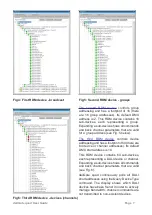
Page 8
daliGate quad User Guide
The selection of LTP vs HTP can be set
on a per output basis using either the web
browser or via Art-Net using DMX-Workshop.
The arbitration of merging differs depending
on the selected lighting protocol:
Art-Net
If two streams from different IP addresses are
directed to the same Port-Address, merging
will occur. If more streams are directed to the
same Port-Address, they will be ignored.
sACN
Merging can operate with both unicast and
multicast data.
If two streams from different IP addresses are
directed to the same universe, the priority field
is checked and the stream with the highest
priority is output. If the priority field in both
streams is identical, merging will occur.
If additional stream(s) are directed to the same
universe, any additional stream with higher
priority will take precedence. If the priority
is identical to the merging streams, it will
be ignored. Please refer to Application Note
“0130 Gateway merging” for more information.
This mode is useful for applications that
require remote control of scenes, such as
corporate foyers or meeting rooms, retail,
high-end residential, schools, museums and
visitor centres.
The remote control interface is provided by
daliScene, a free app developed by Artistic
Licence for controlling DALI scene playback.
It is currently available for Android with the
iOS version to be launched soon. (Also, there
are various OSC apps from other developers
that can be used).
daliScene sends DALI scene playback
commands (using Art-Osc) over a network.
The network can be wired or wireless.
daliGate quad responds to these messages
and translates them to the physical DALI
circuits. This provides multi-circuit DALI
playback controlled by a phone or tablet. The
significance is that daliGate quad operates as
a gateway between a wi-fi access point and
up to four DALI circuits.
The ‘Transmit-Send Art-Osc’ menu in DMX-
Workshop can also be used to send scene
commands.
Operation
daliGate quad can be used in two modes,
This mode is useful for any application where
both DMX and DALI are needed. Streaming
encapsulates the 3 addressing modes of
broadcast, group and device/channel.
y
Use daliGate quad with an Art-Net
capable lighting desk to directly control
DALI gear alongside DMX fixtures.
y
All DALI back channel data (such as
lamp failure, product capability) is
converted to RDM and returned over
Art-Net so that the lighting desk can
view and change the settings.
y
Broadcast, group and device/channel
addressing can be used at same time
to increase flexibility.
y
daliGate quad has a data capture system
built in, allowing it to be used as a test
and analysis tool in combination with
DMX-Workshop.
Mode 1: Streaming
Mode 2: Scene
Squawk
On a complicated network it is not always
easy to relate what is showing on screen to
the physical location of the nodes. A single
press of the factory reset button on daliGate
quad causes the product to send a message
over the network to the console.
daliGate quad is able to merge two streams of
data to a DALI output. The method of merging
will be either HTP or LTP.
In HTP (highest takes precedence), the
levels of each channel in the two streams are
compared and the highest value is used.
In LTP (latest takes precedence), the levels of
each channel in the two streams is compared
to the output; if there is a change, that level
is output.
Merging
which can be used simultaneously: streaming
and scene.






























